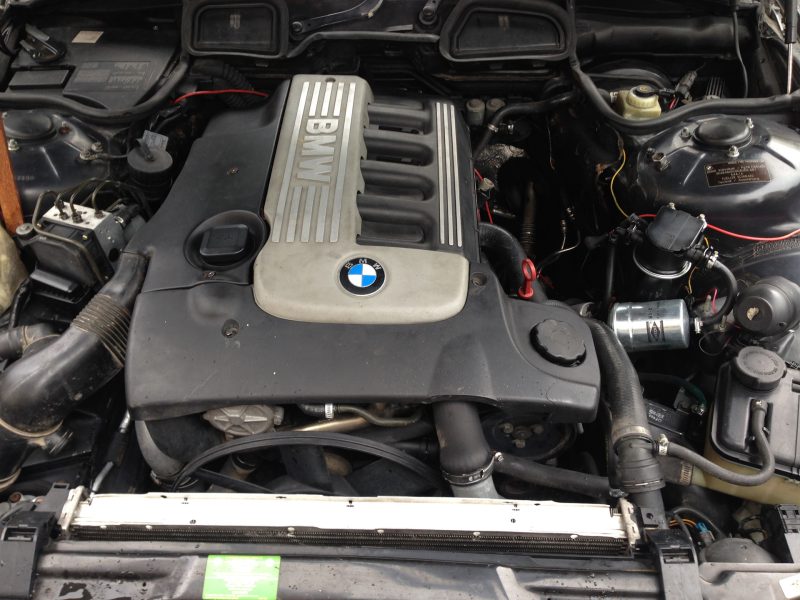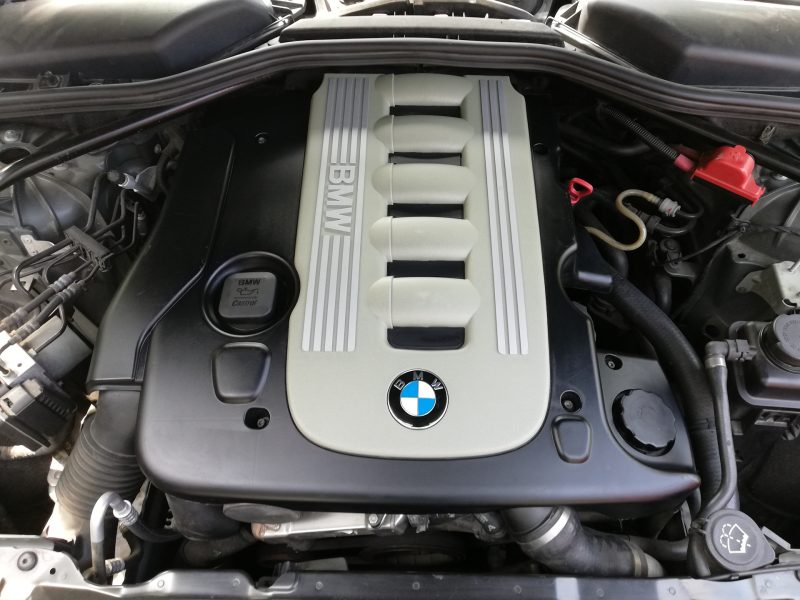One of the best units of German production is considered to be the M57 motor from the BMW concern. The classic inline six has 10 variants of performance. On cars of German production, motors with a volume from 2.5 to 3.0 liters were installed. Power indicators also differ. The simplest power unit develops a capacity of 150 horsepower, the maximum indicator of the motor is 286 hp.
At the initial stage of production of power units used cast iron cylinder block with aluminum cylinder head. The motor was equipped with two camshafts. There were 4 valves for each of the 6 cylinders. Valves with springs matched the younger version of the motor, four-cylinder engine M47.
Differences between the modifications of the power units of 2.5 and 3 liters are in the size of the piston group. For the 150-horsepower engine, which appeared on the market in 1999, the diameter and stroke of the cylinder piston was 80 and 82.8 mm, respectively. The engine, labeled M57D2500, was installed in conjunction with a Garret GT2052V turbocharger.
The 3-liter motor has become significantly more powerful. This effect was achieved by increasing the diameter and stroke of the cylinders to 84 and 88 mm, respectively. The working volume has increased to 2926 cubic centimeters. Instead of the traditional for many models belt, the power unit includes a timing drive with a long service life.
Developers in the creation of the engine used the Common Rail fuel system produced by Bosch. Garret GT2052V turbocharger provides high efficiency of the motor. The base power unit with a volume of 3 liters is equipped with an intake manifold made of aluminum alloy. Vortex flaps are used to close the intake channels.
The flaps are closed when the engine is running at below-average rpm. Fuel is supplied through one of the valves connected to the swirl channel. Such a design provides quality mixing of fuel and air flow. With increasing revolutions, the flaps gradually open.
Varieties of modifications of M57 power units
The first update of the power unit passed in 2002. The new engine was labeled M57TU. To increase the volume of the power unit, the stroke of the cylinder pistons was changed. This indicator reached 90 mm, and the working volume increased to 2993 cubic centimeters. In conjunction with the power plant used a turbine Garret GT2260V.

After another 2 years, the engine again underwent changes. Biturbine modification of the engine received the index M57D30T1. The power unit included BorgWarner compressors, models BV39 and K26. The total power of the power unit reached 272 horsepower. In 2006, another version of the engine with an output of 286 horsepower with the marking M57D30T2 appeared.
| Modification | Operating volume (cm³) | Max. power | Torque | Fitted to |
|---|---|---|---|---|
| M57D25 (Y25DT) | 2497 | 150 hp at 4000 rpm | 300 Nm at 1750 rpm | 2001-2003 on Opel Omega |
| M57D25O0 | 2497 | 163 hp at 4000 rpm | 350 Nm at 2000-2500 rpm | 1999-2004 BMW 525d E39 |
| M57D25O1 | 2497 | 177 hp at 4000 rpm | 400 Nm at 2000-2750 rpm | 2002-2007 on BMW E60/61 525d |
| M57D30 (306D1) | 2926 | 177 hp at 4000 rpm | 390 Nm at 2000 rpm | 2002-2012 Range Rover |
| M57D30O0 | 2926 | 184 hp at 4000 rpm | 390 Nm at 2000 rpm | 1997-2003 on BMW 530d E39, 330d/330xd E46 |
| M57D30O0 | 2926 | 184 hp at 4000 rpm | 410 Nm at 2000-3000 rpm | 1997-2001 on BMW 730d E38, 2000-2003 on BMW X5 3.0d E53 |
| M57D30O0 | 2926 | 193 hp at 4000 rpm | 410 Nm at 1750-3000 rpm | 2000-2004 BMW 530d E39 |
| M57D30O0 | 2926 | 193 hp at 4000 rpm | 430 Nm at 2000-3000 rpm | 2000-2003 BMW 730d E38 |
| M57D30TU (M57D30O1) | 2993 | 204 hp at 4000 rpm | 410 Nm at 1500-3250 rpm | 2002-2005 on BMW 330d/330Cd/330xd E46, BMW X3 3.0d E83, BMW 530d E60, BMW 730d E65 |
| M57D30O2 | 2993 | 218 hp at 4000 rpm | 500 Nm at 2000-2750 rpm | 2004-2010 BMW X3 3.0d E83 |
| M57D30T1 (M57TUTOP) | 2993 | 272 hp at 4000 rpm | 560 Nm at 2000-2250 rpm | 2004-2007 in BMW 535d E60/61 |
| M57D30TU2 (M57TU2) | 2993 | 197 hp at 4000 rpm | 400 Nm at 2000 rpm | 2008-2010 on BMW 325d E90/91, BMW 525d/525xd E60/61 |
| M57D30O2 (M57TU2) | 2993 | 231 hp at 4000 rpm | 500 Nm at 1750-3000 rpm | 2004-2008 on BMW 330d/330xd E90/91, BMW 530d E60/61, BMW 730d E65/66 |
| M57D30O2 (M57TU2) | 2993 | 235 hp at 4000 rpm | 520 Nm at 2000-2750 rpm | 2005-2010 on BMW 530d E60/61, BMW X5 3.0d E70, X6 xDrive 30d E71 |
| M57D30TUTOP (M57D30T2) | 2993 | 286 hp at 4000 rpm | 580 Nm at 2000-2250 rpm | 2005-2010 on BMW 335d E90/E91/E92/E93, 535d E60/61, BMW 635d E63/64, X3 3.0 sd E83, X5 3.0sd E70, X6 xDrive 35d E71 |
The 2.5 liter engine has been modernized only 1 time. In 2004, the developers brought the cylinder diameter to 84 mm, and the piston stroke on the contrary reduced to 75.1 mm. With unchanged volume, the engine performance has improved, largely due to the use of a GT2056V turbine. Since 2007, this power unit was removed from production, completely switching to the 3-liter version. The index of the new motor is M57D30TU2.
The main problems of the M57 motor and ways of solution

Reliability of the classic six is its main advantage. When comparing cars similar in characteristics, the technique with such a motor is sold first. Despite the large power, the power unit is economical and not capricious.
With proper operation and regular maintenance, the engine works without fail for the entire allotted period. Trouble can be caused by vortex flaps. In the process of operation, these elements can get mechanical damage. In the most unpleasant cases, debris enters the combustion chamber. Consequences – failure of pistons and expensive repairs. To prevent this defect, the electronic control unit is removed and reprogrammed to work without the use of flaps.
Another defect is observed on motors with the letters TU in the marking. The intake manifold is made of plastic. It can crack during operation. The consequence is a decrease in power of the power unit, noticeable by eye. Each owner can replace the intake manifold with a plastic analog, avoid problems with the motor.
With prolonged use, the damper pulley of the power unit wears out and breaks. For the M57 motor, this means a strong knock and vibration. The part can be replaced at a specialized service center.
The Common Rail fuel injection system used by the motor is also characterized by reliability and has a long resource. Premature failure of the equipment is most often fixed after refueling with low-quality fuel. If the engine was released before 2003, the injectors can be repaired. Otherwise, they will have to be replaced.
When using a car with an M57 engine, it is necessary to pay attention to the operation of individual mechanisms. Problems can cause problems with electro-vacuum supports, exhaust ventilation system, oil filter cover. Otherwise, the M57 engine is one of the best in the class, has a lot of positive reviews and recommendations.
